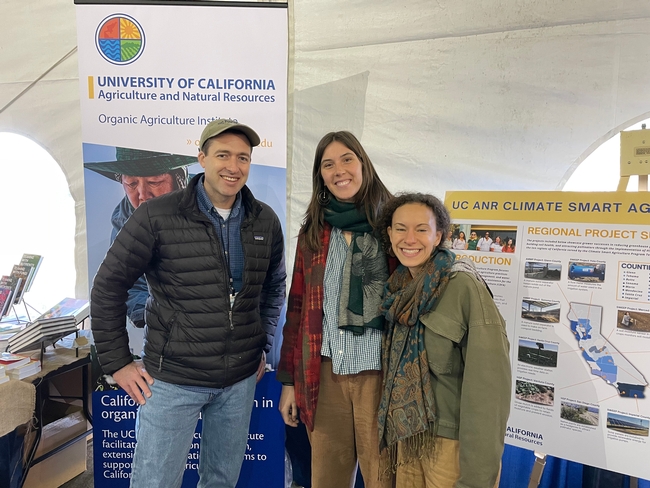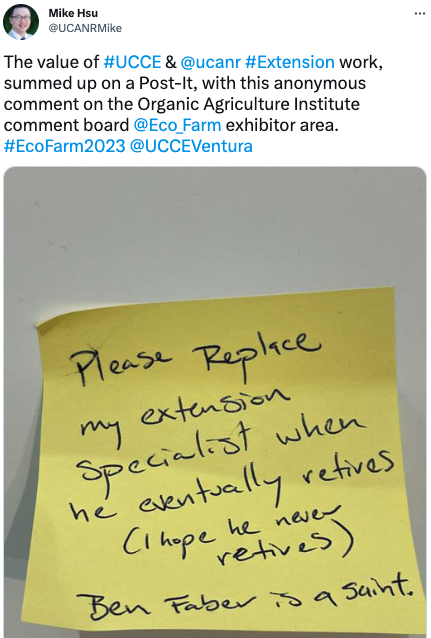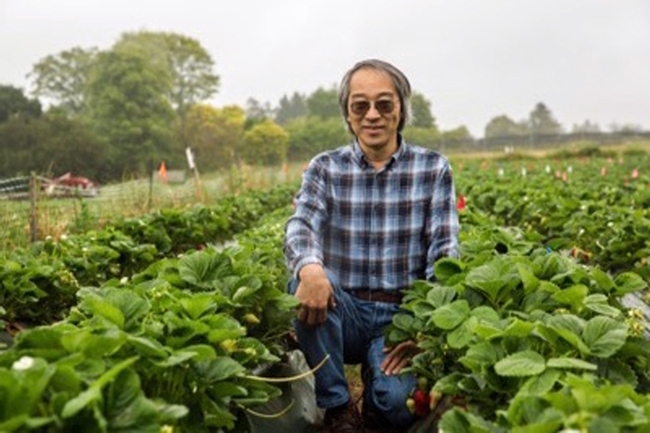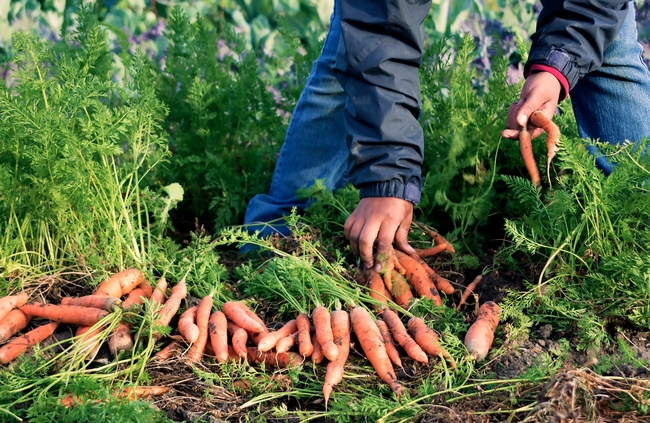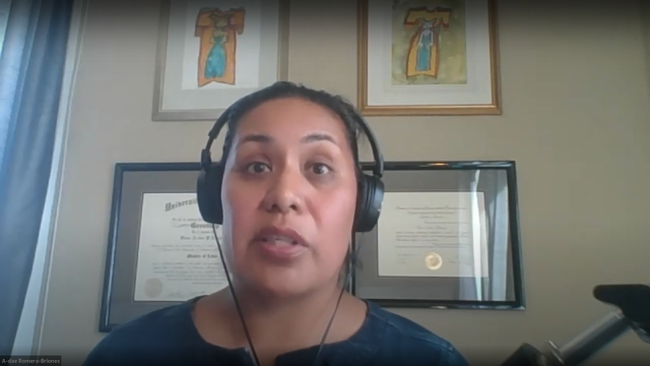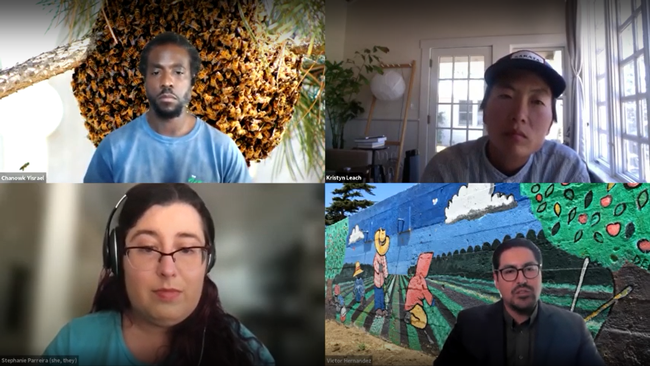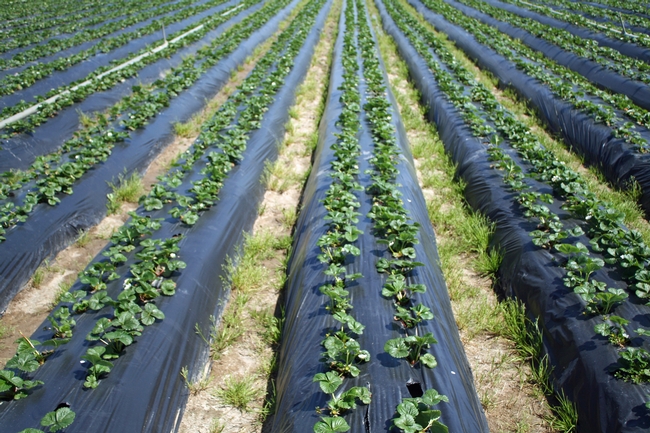Posts Tagged: Organic
UC ANR grows connections, knowledge at EcoFarm
Researchers, staff and affiliates of the UC Organic Agriculture Institute – one of UC ANR's newest programs – raised awareness among attendees of OAI's work and its ongoing statewide needs assessment. Feedback from the organic community will help determine priorities for OAI's future research and extension activities.
UC ANR's Small Farms team was also on hand, providing practical knowledge to the sustainable farming community and sharing during a workshop session their first-hand experiences with participatory on-farm research.
During the conference awards banquet, Gail Feenstra, the former Sustainable Agriculture Research and Education Program director who retired recently, was honored with a Sustie Award. The award recognizes stewards of sustainable agriculture who have made long-term, significant contributions to the well-being of agriculture and the planet. Feenstra's 33-year career was spent advancing more sustainable, resilient and equitable food systems.
To learn more about EcoFarm, see Mike Hsu's tweets with thehashtag #EcoFarm2023.
New California Organic Research Agenda available online
Organic Farming Research Foundation has published the new California Organic Research Agenda (CORA), a comprehensive report that examines current needs and challenges of organic farmers and ranchers across California and provides policy and research recommendations to address producer-identified issues.
The CORA report is a companion to OFRF's 2022 National Organic Research Agenda. The national organic survey data boasts responses from over 1,100 producers and 16 listening sessions held across the U.S. Using the California subset of the national survey data, the CORA report highlights the top production and non-production challenges cited by California's organic farmers and ranchers.
“Organic farming has been historically under-invested in, in terms of research, education and extension,” says OFRF Executive Director Brise Tencer. “Both the new California Organic Research Agenda and the 2022 National Organic Research Agenda present incredible feedback directly from organic farmers and provide a compelling roadmap for how to best support the growth of this important sector of agriculture.”
Report findings indicate that managing production costs is a substantial challenge for 71% of producers surveyed, and accessing labor proved to be the leading non-production challenge. An overwhelming number of state producers (76%) expressed substantial need for technical assistance with the organic management of weeds, pests, and disease. In addition to detailing farmer challenges on and off the field, OFRF's CORA report provides a comparison analysis of farmer responses based on commodity and farming experience. National and state comparisons are also included in the report.
Production of the CORA report was supported in part by the University of California Organic Agriculture Institute (UC OAI), a new statewide program within the UC Division of Agriculture and Natural Resources (UC ANR), as well as the UC Santa Cruz Center for Agroecology.
“One of our primary activities is to generate new research and extension programs focused on organic agriculture,” says Houston Wilson, director of the UC OAI. “The CORA report provides an excellent roadmap to guide and prioritize our efforts, we're really excited to turn this information into action.”
According to the California Department of Food & Agriculture, state farmers and ranchers were responsible for 40% of all organic agricultural product sales in the country. Data from a 2019 USDA organic survey concludes California has 965,257 acres in organic production, which is approximately 17.5% of all organic acreage in the country. OFRF's California Organic Research Agenda examines grower needs in the nation's top-producing state of organic agricultural commodities and specialty crops, paving the way for future research and investment.
"This report will benefit organic growers in California by playing a role as a critical reference to increase public support and develop research projects targeting specific needs that diverse organic growers in the state are facing," says Joji Muramoto, UC Cooperative Extension organic production specialist.
Each report is available online (www.ofrf.org/research/nora/) free of charge to farmers, policymakers, ag suppliers, seed companies, and the general public.
Farmers of color share their contributions, concerns in UC SAREP webinar series
When agricultural advisors came to the Cochiti Pueblo in New Mexico during the 1940s, they lined the irrigation ditches with concrete, in the name of boosting efficiency and productivity. But in single-mindedly focusing on water delivery, they neglected to consider how the previously inefficient seepage sustained nearby fruit trees.
Their actions, as well-intentioned as they might have been, disrupted the local ecosystem and killed the trees that had fed many generations, according to A-dae Romero-Briones, who identifies as Cochiti and as a member of the Kiowa Tribe.
“In my language, we call the extension agents ‘the people who kill the fruit trees,'” said Romero-Briones, director of the Food and Agriculture Program for the First Nations Development Institute, a nonprofit that serves Tribal communities across the mainland, Alaska and Hawaii.
The historically tense relationship between Indigenous peoples and government-affiliated programs is one of the many complex dynamics discussed in a six-part webinar series, “Racial Equity in Extension,” facilitated by UC Sustainable Agriculture Research and Education Program.
Making communities of color in the agricultural sector more visible is a priority for Victor Hernandez, a sociologist and outreach coordinator for the USDA's Natural Resources Conservation Service. Hernandez, who has organized “Growing Together” conferences for Latino and Black farmers, is trying to get more farmers of color to participate in the upcoming 2022 Agricultural Census.
“If we cannot quantify the demographic, we cannot justify the need,” emphasized Hernandez, explaining that his office uses the data to direct resources that advance equity in service, program delivery and distribution of funds.
A legacy of mistrust
At the same time, however, Hernandez also acknowledged the challenges in registering growers of color for the census, conducted by the USDA's National Agricultural Statistics Service. (According to Brodt, USDA's most recent agricultural census, dating to 2017, counts approximately 25,000 producers of color among 128,535 total producers in California.)
“Many of us that are considered socially disadvantaged or historically underserved…a lot of times our peoples come from [nations with] oppressive governments,” Hernandez said. “And so when you come to the United States and you begin to build your life here, to go and engage with the federal government is not the first knee-jerk reaction.”
On top of government mistrust and fears of deportation or detention, other immigrant groups have seen mainstream agriculture – borne by the “Green Revolution” wave across the globe – replace deep-rooted cultural practices, said Kristyn Leach of Namu Farm in Winters.
“It just makes these small farmers distrust our own knowledge, the knowledge that's existed for centuries – before the kind of current iteration of agriculture that we're situated within right now,” said Leach, who works to preserve the agricultural heritage of her Korean ancestors, and facilitates a farmers' collaborative called Second Generation that adapts Asian crop varieties to climate change.
According to Romero-Briones, a collective memory of supplanted culture also lingers in Indigenous communities. In the Cochiti Pueblo, “primarily a subsistence agriculture community” with a long history of corn cultivation, their practices are distinct from those in the mainstream – including regenerative and sustainable agriculture.
Building relationships takes commitment
Given that legacy of cultural displacement and appropriation, how do extension professionals and other agricultural advisors slowly rebuild trust with communities of color? For Romero-Briones, it begins with a genuine respect for Indigenous practices, and she urges interested people to contact their local tribal historic preservation officer to begin strengthening those connections and understanding – beyond a couple of phone calls.
“As someone who works with Indigenous people all day, even I need to recognize sometimes I have to meet with people up to 12 times before we actually start talking about the work that I initially wanted to talk to them about,” Romero-Briones said.
In a similar vein, Chanowk Yisrael, chief seed starter of Yisrael Family Farms, encouraged listeners to reach out to members of the California Farmer Justice Collaborative – an organization striving for a fair food system while challenging racism and centering farmers of color.
“To use a farm analogy: we've got this ground, which is the farmers of color who have been neglected for a long period of time,” said Yisrael, who has grown his farm in a historically Black neighborhood of Sacramento into a catalyst for social change. “It's not just going to be as simple as just throwing some seeds and things are going to come up; you're going to have to do more – that means you got to get out and do much more than you would do for any other community.”
Investing time in a community is one thing – and backing it up with tangible resources is another. Technical expertise is only the “tip of the iceberg,” Leach said, as historically marginalized groups are also seeking land access and tenure, more affordable cost of living, and access to capital.
“All of those things are actually much bigger burdens to bear for most communities of color than not having the knowledge of how to grow the crops that we want to grow, and not knowing how to be adaptive and nimble in the face of climate change," Leach explained, highlighting California FarmLink as an essential resource. (“Understanding Disparities in Farmland Ownership” is the next webinar in the SAREP series, set for Nov. 19.)
Bringing diverse voices to the table
Another key is ensuring that farmers and farm workers of color are represented in management and decision-making processes. Samuel Sandoval, a professor in the Department of Land, Air and Water Resources and UC Cooperative Extension specialist in water management, develops outreach programs in English and Spanish for everyone from farm workers to the “boss of the boss of the boss.”
“It has to be changed,” he said, “because at the end, the person who is going to operate the irrigation system and turn on or off the valves, the person who is looking if there's a leak or not – that's the person who's not being informed, or has not been informed on purpose.”
That exclusion of certain groups can lead to a loss of invaluable knowledge. Leach said there is a real danger in ignoring the wisdom of communities that have contributed so much to the foundation of food systems in California and around the globe.
“These really kind of amazing, sophisticated and elegant agroecological systems that we don't often legitimize through the scientific language and perspectives aren't seen as being really technically proficient – but, in many ways, they're more dynamic and more resilient than the things that we're perpetuating right now,” she said.
As a concrete example, Sandoval said that while extension advisors and specialists conduct studies to remedy a plant disease, farm workers might be developing – separately and in parallel – their own solutions by asking for advice from their social networks via WhatsApp, a phone application.
A reimagining of collaboration, Sandoval said, would include (and compensate) people working in the field for sharing their perspectives – bringing together academics and farmers, integrated pest management experts and pesticide applicators, irrigation specialists and those who do the irrigation.
A need to look within
Concerns about inclusion and validating alternate sources of knowledge apply also to the recruitment process in extension. Leach said that she has seen listings for advisor jobs that would require, at a minimum, a master's degree – which would automatically disqualify her, despite her extensive knowledge of Asian heirloom vegetables.
“When you look at a job description and you see ‘Asian crop specialist,' only required qualification is a master's degree, and then somewhere down the long list of sort of secondary desired, recommended things is some knowledge of Asian crops or communities…you know that just says a lot in terms of what has weight,” Leach explained.
Before organizations can authentically connect with communities of color, they should prioritize diversity in their own ranks, said Romero-Briones. First Nations Development Institute had to ensure that they had adequate representation across the many Tribes that they serve.
“Before we start looking out, we have to start looking in,” she explained, “and that means we have to hire Indigenous people who know these communities.”
For extension professionals and other members of the agricultural community in California, the UC SAREP webinar series has helped spark that introspection and a meaningful reevaluation of institutional processes and assumptions.
“These discussions have been tremendously illuminating and eye-opening,” Brodt said. “But hearing and learning is just the start – it's incumbent on us, as an organization and as individuals, to take action to ensure that farmers of color and their foodways are truly respected and valued.”
Recruitment for California Organic Institute director underway
Applications are being accepted through March 30, 2020, from UC Cooperative Extension specialists and advisors who wish to be considered for the position of director of UC ANR's California Organic Institute. This opportunity will provide a dedicated source of funds (income from the endowment) to support scholarly activities and outreach focused on improvement of California organic agriculture production.
Through a funding partnership between Clif Bar & Company and the UC Presidential Endowment program, UC Agriculture and Natural Resources has established a $1 million directorship for the UC ANR California Organic Institute.
Through a competitive selection process, a director will be chosen to hold an initial seven-year term.The directorship will be awarded by UC ANR to a distinguished UC Cooperative Extension specialist or advisor currently working in the area of organic production in California.
Application and selection details, including timeline and submission guidelines, are available at http://ucanr.edu/sites/StrategicInitiatives/files/318017.pdf.
For any questions, please contact Mark Bell, vice provost for strategic initiatives & statewide programs, at mozbell@ucanr.edu.
Clif Bar invests in UC’s first organic research institute
The University of California system's first-ever institute for organic research and education will be established in UC ANR with a $500,000 endowment gift from Clif Bar & Company and $500,000 in matching funds from UC President Janet Napolitano.
The California Organic Institute will accelerate the development and adoption of effective tools and practices for organic farmers and those transitioning to organic by building on the capabilities of UC ANR's Cooperative Extension and Sustainable Agriculture Research and Education Program. Although organic is the fastest growing sector of the food economy, funding for research has lagged far behind support for conventional agriculture. Farmers interested in transitioning to organic or improving performance of their organic systems often lack the guidance they need to succeed.
“California's organic farmers already benefit from UC ANR's pest management, irrigation and crop production research, and this partnership with Clif Bar will give UC more capacity to focus on challenges specific to organic farming,” said Glenda Humiston, UC vice president of agriculture and natural resources. “UC Cooperative Extension advisors work directly with farmers throughout the state so new organic farming techniques can be applied quickly.”
The California Organic Institute is Clif Bar's third organic research endowment and the first in its home state of California, where the company sources several key organic ingredients. Clif Bar is not alone in sourcing from the state, which has the most organic farms in the U.S.: California's nearly 3,000 certified organic farms grow crops on land that represents 21% of all U.S. certified organic land.
“The California Organic Institute will serve many of the organic producers we depend on for ingredients like almonds and figs, as well as farmers outside our supply chain,” said Lynn Ineson, vice president of Sustainable Sourcing for Clif Bar. “We recognize that the future of our food company depends on the ecological and economic success of organic and transitioning farmers.”
Recruitment for an institute director will begin in early 2020, with a search committee including industry representatives and partners. The director will work with a permanent advisory committee, Clif Bar, and UC ANR to launch the institute and recruit additional like-minded partners to support its long-term success.
Ultimately, with the support of UC ANR and a constellation of partners, the California Organic Institute will be in a strong position to increase the performance of organic farming for improved stewardship of natural resources, the economic well-being of rural communities, and greater stability for the next generation of California farmers.

